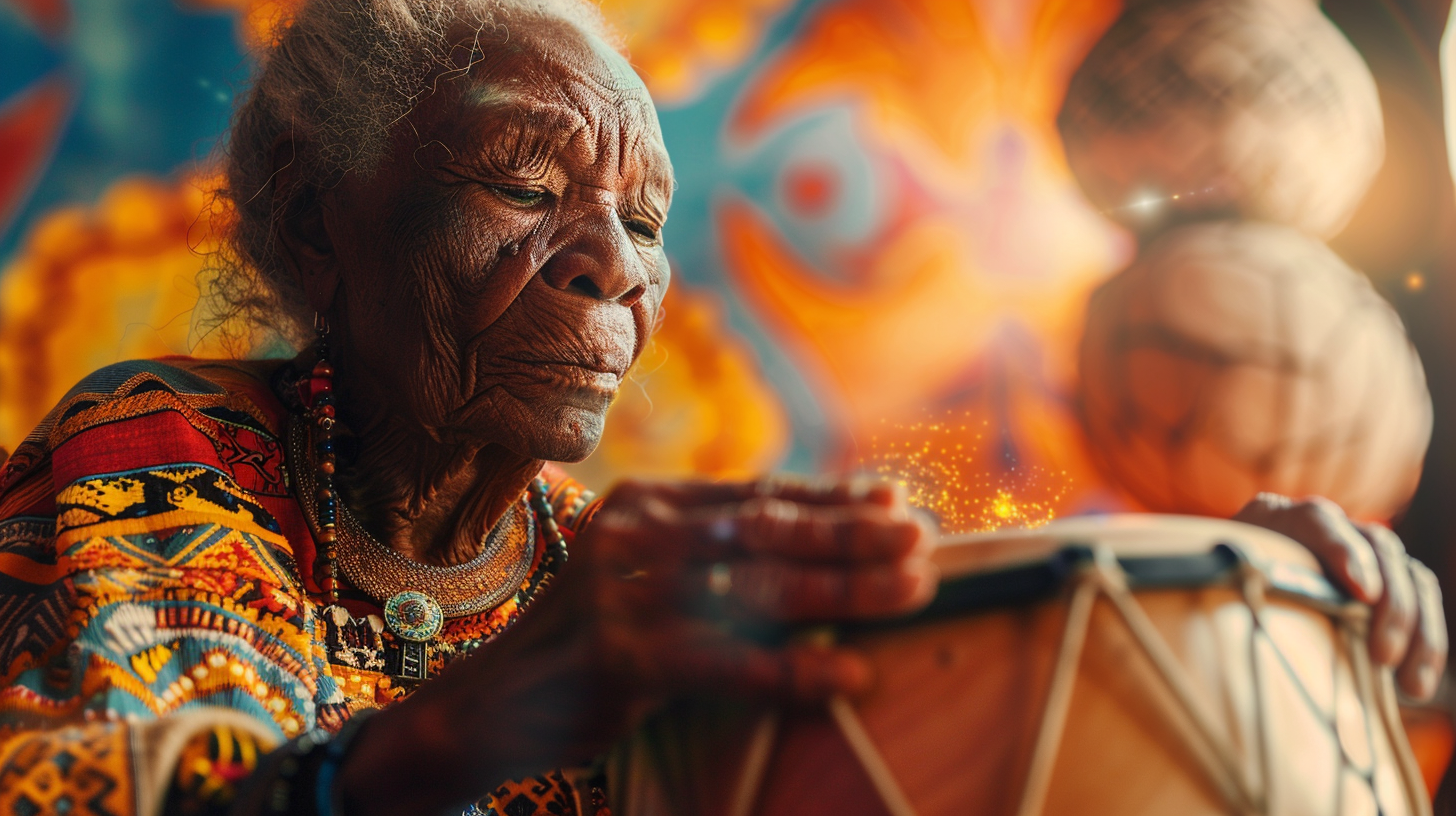Table of Contents Show
Isn’t it intriguing how the ancient art of storytelling, passed down through generations by our elders, remains a cornerstone in preserving our cultural heritage? We’ve come to appreciate the profound impact these narratives hold in bridging the gap between past and present, offering invaluable lessons and insights into our identity and values. As we navigate the complexities of modern challenges, the wisdom of our elders and their stories take on a new significance. But how exactly does this age-old tradition fit into our fast-paced, digital world? Join us as we explore the evolving role of storytelling in ensuring cultural continuity, promising a journey filled with discoveries and reflections on our collective past and future.
Key Takeaways
- Elders are crucial for guiding younger generations through modern challenges with wisdom and resilience.
- Storytelling traditions play a key role in preserving cultural identity and connecting communities.
- Modern technologies offer new avenues for preserving and sharing cultural narratives and languages.
- Environmental wisdom and sustainable practices can be effectively transmitted through the insights of elders and storytelling.
Understanding Cultural Continuity
Cultural continuity, at its core, is the unbroken thread that connects generations through shared beliefs, practices, and traditions. It’s what keeps our identity alive and kicking, ensuring that the essence of who we are isn’t lost to the sands of time. We’re not just talking about keeping customs for the sake of nostalgia; it’s about preserving our unique way of life in a world that’s constantly changing.
For us, it’s about freedom—the freedom to be ourselves, to celebrate where we come from, and to shape our future without losing sight of our past. We’ve seen how easy it is for cultures to become diluted in the global melting pot, and we’re determined not to let that happen to us. We embrace modernity, sure, but we do it on our own terms, making sure that our traditions aren’t just footnotes in history books.
We’ve found that the key to achieving this balance lies in active participation. It’s not enough to passively inherit our culture; we must actively engage with it, question it, and, when necessary, adapt it. This doesn’t mean abandoning our roots but ensuring they remain relevant and vibrant.
In a world that often values uniformity, standing up for our cultural identity is a bold act of freedom. It’s a declaration that we value diversity and the richness it brings to the human experience. We’re committed to keeping our culture’s flame burning brightly, illuminating the path for generations to come.
The Wisdom of Elders
In the tapestry of our community, elders are the weavers of wisdom, guiding us through the complexities of our traditions with their lived experiences. They’ve journeyed through times we can only imagine, facing challenges and embracing changes that have shaped our world. Their insights aren’t just valuable; they’re indispensable for us to navigate our lives with a sense of purpose and connection to our roots.
We lean on their wisdom, not because we’re incapable of finding our own way, but because their guidance empowers us to move forward with confidence. They don’t just offer advice; they share life lessons that resonate with our desire for freedom and self-determination. It’s through their eyes we learn the importance of resilience, the power of patience, and the beauty of embracing our identity.
Their wisdom isn’t confined to the past; it’s a beacon for the future. As we endeavor to carve out our paths, we’re reminded that freedom isn’t just about the choices we make; it’s about understanding the legacy we’re part of and the legacy we want to leave behind. Elders teach us that our actions today are the seeds of tomorrow’s traditions.
In our quest for freedom, we find strength in their wisdom. It’s a reminder that while we’re enthusiastic to forge our own way, we’re never alone. We’re part of a continuum, a living bridge between the past and the future, and our elders are the guiding lights, illuminating the path with their wisdom.
Storytelling Traditions
We’re now turning our focus to storytelling traditions, an essential thread in the fabric of our cultures. We’ll explore how ancient origins are being rediscovered, the techniques used in oral history, and their profound impact on cultural identity. These elements together illuminate the depth and resilience of our collective heritage.
Ancient Origins Rediscovered
Delving into history, we discover that storytelling traditions serve as a bridge to our ancient origins, rekindling a connection with the past. These narratives aren’t just tales; they’re lifelines to the wisdom and experiences of those who walked before us. By embracing these stories, we’re not just recalling history; we’re living it, breathing new life into ancient words and deeds. It’s a profound way to make sure that the freedoms, lessons, and values of our ancestors aren’t lost to time but are instead passed down, vibrant and resonant. We’re not merely keepers of stories; we’re the voice of generations, echoing through time. This rediscovery isn’t just about looking back; it’s a bold step toward preserving our cultural identity and making sure its survival into the future.
Techniques in Oral History
Exploring the techniques in oral history, we find storytelling traditions rich with methods to preserve and transmit culture. We’ve harnessed the power of narrative, using vivid imagery and engaging narratives to keep our heritage alive. Our ancestors tapped into the rhythm and flow of language, crafting stories that resonate deeply within us. We use repetition for emphasis, ensuring key points are remembered and passed down. Call-and-response techniques foster a dynamic interaction, making the storytelling process a communal experience. By embodying characters and employing dramatic pauses, we captivate listeners, drawing them into the tale. These methods aren’t just about preserving the past; they’re our way of claiming autonomy over how we share and sustain our cultural narratives, free from external constraints.
Impact on Cultural Identity
Building on our exploration of oral history techniques, storytelling traditions play a pivotal role in shaping and reinforcing our cultural identity. Through the tales we’ve inherited, we connect with our ancestors, understanding their struggles, victories, and values. This connection isn’t just about preserving the past; it’s about defining who we are today and guiding who we want to become tomorrow. Our stories are the threads that weave the fabric of our community, each narrative adding color and strength. They remind us that we’re part of something larger than ourselves, a continuum of wisdom and experience. Embracing storytelling helps us maintain our distinctiveness in a globalized world, ensuring our cultural identity isn’t just remembered but lived and breathed every day.
Bridging Generations
Traditionally, elders have played a pivotal role in connecting generations through the powerful medium of storytelling. It’s how we’ve kept our heritage alive, ensuring that the wisdom of the past isn’t lost to the sands of time. In a world that’s constantly changing, the stories they share serve as bridges—timeless links that bind us to our ancestors while paving the way for future generations.
We’ve witnessed firsthand how these narratives spark conversations between the young and the old, creating a shared space where knowledge and experiences are exchanged freely. It’s in these moments that we truly appreciate the beauty of our culture and the strength of our communal bonds.
To give you a clearer picture, we’ve laid out some key aspects of this generational bridge-building in the table below:
| Aspect of Storytelling | Impact on Bridging Generations |
|---|---|
| Transmission of Values | Fosters a sense of identity and belonging among the youth. |
| Preservation of History | Keeps the memory of our ancestors alive for future generations. |
| Sharing of Wisdom | Equips the young with knowledge to navigate life’s challenges. |
| Cultural Understanding | Promotes empathy and respect for our heritage and traditions. |
| Encouragement of Dialogue | Facilitates open communication, ensuring that no voice is left unheard. |
In our pursuit of freedom and self-expression, we mustn’t overlook the lessons embedded within these stories. They’re not just tales of old; they’re the keys to understanding who we are and where we’re headed. Let’s cherish them, for in doing so, we bridge generations and fortify the essence of our cultural continuity.
Lessons in Modern Challenges
As we confront today’s hurdles, we recognize the importance of our elders in guiding us through modern challenges. They offer invaluable insights on steering through digital divides, sharing environmental wisdom, and preserving our linguistic identity. These lessons are pivotal for our cultural continuity and adapting to the ever-changing world.
Navigating Digital Divides
We’re facing a critical challenge in bridging the digital divide to guarantee the timeless tradition of storytelling continues across generations. As we navigate this divide, it’s important to understand the barriers and opportunities technology presents in preserving our cultural narratives. Here’s how we can overcome these hurdles:
- Empowerment through Education: Make sure that everyone, especially our elders, has access to digital literacy programs.
- Inclusive Technology: Develop and utilize platforms that are user-friendly for all ages, making digital storytelling accessible to everyone.
- Collaborative Efforts: Foster partnerships between technologists and cultural custodians to create digital archives that honor our traditions.
Environmental Wisdom Sharing
In facing today’s environmental challenges, we draw on the wisdom of our elders to guide us through sustainable practices. They’ve lived harmoniously with nature, understanding its rhythms and secrets, which now empowers us to tackle modern issues like climate change and pollution. Their stories aren’t just tales; they’re blueprints for living sustainably. We’re learning to respect natural resources, to plant and harvest according to ancient wisdom that once flourished across our lands. This knowledge isn’t just about survival; it’s about thriving in harmony with our environment. Embracing these lessons, we’re not just preserving our past; we’re safeguarding our future. It’s a path to freedom, allowing us to navigate the complexities of today’s world while remaining true to our roots.
Preserving Language Identity
Just like the environmental wisdom passed down from our elders, preserving our language identity is key to facing modern challenges. Our tongues weave the fabric of our cultures, carrying stories, traditions, and the essence of who we are into the future. In the face of globalization, it’s our responsibility to guarantee our linguistic heritage isn’t lost to homogenization. Here’s how we’re tackling this:
- Incorporating language into daily rituals – Making our language a part of everyday life guarantees it remains vibrant and relevant.
- Leveraging technology – Using apps and online resources to learn and practice our language, making it accessible to everyone.
- Storytelling gatherings – Organizing events where elders and youth can share stories, songs, and poems, breathing life into our words.
In doing so, we’re not just preserving our language; we’re reaffirming our freedom to be ourselves.
The Power of Folklore
Folklore holds an unparalleled power in weaving the fabric of cultural identity and continuity. Through the tales passed down from one generation to the next, we keep the essence of who we are alive, allowing our traditions to breathe and evolve with time. These stories aren’t just relics of the past; they’re blueprints for understanding our world and ourselves. They teach us values, inspire us with heroes’ journeys, and caution us through tales of folly.
We’ve seen firsthand how folklore acts as a compass for personal and collective freedom. It’s in these narratives that we find the courage to dream, the strength to resist, and the wisdom to navigate life’s complexities. Here’s a glance at what makes folklore so crucial to our cultural tapestry:
| Aspect | Function | Impact |
|---|---|---|
| Myths | Explain the unexplainable | Connect us to our origins |
| Legends | Celebrate historical deeds | Instill pride and a sense of belonging |
| Fables | Impart moral lessons | Guide ethical behavior |
| Folk songs | Preserve language and express collective emotions | Enhance community cohesion |
Each component of folklore serves a unique purpose, collectively ensuring that our cultural identity isn’t just preserved but is vibrantly alive and kicking. We’re not merely passing down stories; we’re entrusting the next generation with the keys to our collective soul. It’s through these tales that we assert our identity, learn from our ancestors, and find our place in the world. Folklore, in its essence, is the ultimate act of cultural defiance and freedom, setting the stage for a future where our traditions and values continue to flourish.
Guardians of Heritage
Who are the protectors of our cultural heritage, guaranteeing its passage through generations? We’ve come to recognize them as our elders, storytellers, and cultural institutions – each playing a pivotal role in the preservation and transmission of our collective memories, traditions, and values. They’re not just keepers of the past; they’re active participants in shaping a future that remains connected to our roots.
To truly appreciate their significance, consider the following aspects of their role:
-
Elders as Living Libraries: They’re the embodiment of our history, carrying within them the wisdom of ages and traditions that have been passed down orally from one generation to the next. They’re our direct link to the past, offering insights and lessons that are not found in written records.
-
Storytellers as Cultural Conduits: Through tales, myths, and legends, storytellers breathe life into our heritage. They weave narratives that captivate and educate, ensuring that the essence of our culture is not only remembered but felt deeply by those who listen.
-
Cultural Institutions as Preservationists: Museums, libraries, and educational institutions act as protectors by collecting, preserving, and showcasing our tangible and intangible heritage. They provide a space where our cultural expressions can be studied, understood, and appreciated by all.
We stand as witnesses to the power of these protectors, whose dedication ensures that our cultural heritage isn’t just a relic of the past but a living, breathing aspect of our identity. They remind us that freedom isn’t just about moving forward; it’s about carrying with us the essence of who we are and where we’ve come from.
Values Through Narratives
Through storytelling, we transmit core values from one generation to the next, ensuring that the lessons learned are not only remembered but lived by. It’s our way of keeping our heritage alive, of guiding the younger ones without imposing rules in a way that feels restrictive. We’re handing them the keys to understanding right from wrong, respect, courage, and kindness through tales that have traveled through time.
We’ve found that stories resonate. They stick better than lectures. When we share tales of bravery, sacrifice, and wisdom, we’re not just entertaining. We’re instilling values. It’s a subtle art, one that we’ve honed over centuries, adapting to the times but never losing the essence. The beauty lies in the freedom it offers. We’re not dictating what to think but encouraging how to think.
In these narratives, heroes and heroines face trials, make choices, and bear the consequences. Listeners learn the importance of integrity, perseverance, and empathy—not because we tell them to but because they feel it. They’re free to interpret, to agree or question. It’s a dialogue, not a monologue.
Further, we’re preserving more than just morals. We’re safeguarding our way of life, ensuring it thrives in the hearts and minds of those who come after us. It’s a responsibility we carry with pride, a labor of love that binds us across generations.
Essentially, our stories are more than just tales. They’re the threads that weave the fabric of our society—colorful, diverse, and rich with the wisdom of ages. Through them, we’re crafting a legacy of values that champion freedom, understanding, and respect.
The Identity of Communities
Our shared stories not only shape individual values but also forge the unique identity of our community. Through the ages, our elders have passed down tales that do more than entertain; they embed within us a sense of belonging, a connection to our roots, and an understanding of our place in the world. These narratives hold the power to unite us, showcasing our collective experiences and the wisdom of our ancestors. In embracing these stories, we embrace the essence of who we are as a people.
To truly appreciate the impact of storytelling on our community’s identity, consider the following:
-
Shared Values and Beliefs: Our stories often reflect the core principles and morals upheld by our community. They serve as a compass, guiding us through life’s challenges and decisions, ensuring that we remain true to our shared ethos.
-
Cultural Nuances and Traditions: Each tale is a vessel carrying the unique customs and practices of our community. Through storytelling, we preserve the intricate details of our cultural heritage, ensuring that they’re not lost to the sands of time.
-
Collective History and Memory: Our narratives are the threads that weave the fabric of our communal memory. They keep alive the tales of triumph, sacrifice, and resilience that have shaped our collective journey.
In a world that often champions individualism, our stories remind us of the strength found in unity and shared purpose. They are the cornerstone upon which our community stands, a testimony to our enduring spirit and the unwavering bond that connects us all.
Preserving Ancestral Legacy
We’ve explored how storytelling shapes our community’s identity, and now we turn our focus to preserving our ancestral legacy. Through the transmission of ancestral knowledge and the telling of stories, we uphold the wisdom of our forebears alive in the present. It’s through these narratives that we guarantee their legacies endure, guiding us and future generations.
Ancestral Knowledge Transmission
Elders play an important role in passing down ancestral knowledge, ensuring our cultural heritage isn’t lost to time. They’re the backbone of our communities, holding the keys to our past and guiding us towards a future that’s rich with tradition and wisdom. We’re not just preserving history; we’re keeping alive the spirit of our ancestors, allowing their insights and experiences to shape our own paths.
To truly appreciate their contribution, consider these aspects:
- Skills and Crafts: Traditional methods of building, cooking, and healing are taught, preserving unique cultural practices.
- Ethical Guidelines: Elders impart moral values and principles, shaping the community’s ethical backbone.
- Environmental Wisdom: They pass on knowledge about the land and sustainable living, ensuring we live in harmony with nature.
Legacy Through Stories
Through storytelling, we connect with our ancestors, carrying forward their legacies and wisdom into future generations. It’s our way to honor them, ensuring their struggles, victories, and life lessons aren’t lost in the sands of time. We weave their stories into our daily lives, allowing us to hold onto our roots while guiding the freedoms of the modern world. This act of storytelling isn’t just about remembrance; it’s a declaration of our identity, shaped by the past but looking towards the future. By sharing these tales, we’re not just preserving history; we’re actively participating in the legacy of our ancestors, making sure their voices, silenced by time, are still heard loud and clear today. It’s how we keep our heritage alive, vibrant, and relevant.
The Future of Storytelling
As technology evolves, so too does the method and reach of storytelling, offering new platforms and possibilities for cultural narratives to flourish. We’re stepping into a future where our stories aren’t just told; they’re experienced in ways we’ve only begun to explore. This shift isn’t just about preserving our past; it’s about expanding our ability to share, connect, and understand one another on a level we’ve never seen before.
Here are three pivotal changes we’re anticipating:
-
Virtual Reality (VR) and Augmented Reality (AR) Experiences: Imagine stepping into the stories of our ancestors, walking alongside them, and experiencing their world as if we were there. VR and AR can make this possible, transforming storytelling into an immersive experience that can deepen our connection to our cultural heritage.
-
Interactive Storytelling Platforms: We’re looking at platforms that allow for a more interactive form of storytelling. These aren’t just spaces for listening or watching but engaging. Audiences can influence the direction of the story, making each experience unique and deeply personal.
-
Global Story Sharing: With the rise of social media and digital platforms, we’ve got the power to share our stories with a global audience. This doesn’t just preserve our culture; it allows it to evolve and interact with others, creating a rich tapestry of interconnected narratives.
We’re on the brink of a storytelling revolution that promises to liberate our narratives, giving them new life and ensuring they reach hearts and minds across the globe. It’s an exciting time to be a storyteller, and we’re here for it.
Conclusion
In wrapping up, we’ve seen that elders and storytelling aren’t just relics of the past, but essential threads in the fabric of our culture. They bridge generations, teaching us values and wisdom that help navigate modern challenges. Through stories, we preserve our ancestral legacy and shape our community’s identity. As we pass these tales from one generation to the next, it’s clear that the pen is indeed mightier than the sword, ensuring the future of storytelling remains bright and enduring.








